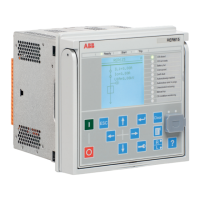For example, if the resistive current of the parallel resistor is 10 A (at primary voltage
level), then a value of 0.5 · 10 A = 5 A could be used. The same setting is also
applicable in case the coil is disconnected and the network becomes unearthed (as
in this case this setting is compared to the amplitude of
). The selected setting
value must never exceed the ampere value of the parallel resistor in order to allow
operation in the faulty feeder. In case of smaller ampere value of the parallel resistor,
for example 5 A, the recommended security factor should be larger, for example 0.7,
so that sufficient margin for CT and VT errors can be achieved.
In case the “Amplitude” operating quantity is selected, the setting should be
selected based on the capacitive earth-fault current values produced by the
background network in case of a solid earth fault with a security margin.
The main task of the current magnitude supervision module is to secure
the correct directional determination of an earth fault, so that only the
faulty feeder is disconnected or alarmed. Therefore, the threshold values
should be selected carefully and not set too high as this can inhibit the
disconnection of the faulty feeder.
The residual current should be measured with accurate core balance
current transformer to minimize the measurement errors, especially
phase displacement.
Transient detector
The Transient detector module is used for detecting transients in the residual
current and zero-sequence voltage signals. Whenever transient is detected, this
is indicated with the PEAK_IND output. When the number of detected transients
equals or exceeds the
Peak counter limit
setting (without the function being reset,
depending on the drop-off time set with the
Reset delay time
setting), INTR_EF
output is activated. This indicates detection of restriking or intermittent earth fault
in the network. Transient detector affects the operation of MFADPSDE ( START and
OPERATE outputs) when operation mode is “Intermittent EF”. For other operation
modes, (“General EF”, “Alarming EF”), PEAK_IND and INTR_EF outputs can be used
for monitoring purposes. The operation of the Transient detector is illustrated in
Figure 199
.
Several factors affect the magnitude and frequency of fault transients,
such as the fault inception angle on the voltage wave, fault location,
fault resistance and the parameters of the feeders and the supplying
transformers. If the fault is permanent (non-transient) in nature,
the initial fault transient in current and voltage can be measured,
whereas the intermittent fault creates repetitive transients. The practical
sensitivity of transient detection is limited to approximately few
hundreds of ohms of fault resistance. Therefore the application of
transient detection is limited to low ohmic earth faults.
Protection functions 1MRS758755 C
398 REC615 & RER615
Technical Manual

